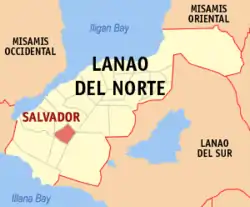Salvador, Lanao del Norte
Salvador, officially the Municipality of Salvador (Maranao: Inged a Salvador; Cebuano: Lungsod sa Salvador; Tagalog: Bayan ng Salvador), is a 5th class municipality in the province of Lanao del Norte, Philippines. According to the 2015 census, it has a population of 31,845 people. [3]
Salvador | |
|---|---|
| Municipality of Salvador | |
 Map of Lanao del Norte with Salvador highlighted | |
OpenStreetMap 
| |
.svg.png.webp) Salvador Location within the Philippines | |
| Coordinates: 7°54′N 123°51′E | |
| Country | |
| Region | Northern Mindanao (Region X) |
| Province | Lanao del Norte |
| District | 2nd District |
| Founded | January 13, 1960 |
| Barangays | 25 (see Barangays) |
| Government | |
| • Type | Sangguniang Bayan |
| • Mayor | Farhanie A. Tawantawan |
| • Vice Mayor | Mateo M. Cortes |
| • Representative | Abdullah D. Dimaporo |
| • Electorate | 12,868 voters (2019) |
| Area | |
| • Total | 113.99 km2 (44.01 sq mi) |
| Elevation | 69 m (226 ft) |
| Population | |
| • Total | 31,845 |
| • Density | 280/km2 (720/sq mi) |
| • Households | 6,830 |
| Economy | |
| • Income class | 5th municipal income class |
| • Poverty incidence | 62.76% (2015)[4] |
| • Revenue | ₱69,890,206.94 (2016) |
| Time zone | UTC+8 (PST) |
| ZIP code | 9212 |
| PSGC | |
| IDD : area code | +63 (0)63 |
| Climate type | tropical climate |
| Native languages | Maranao Cebuano Binukid Tagalog |
| Website | www |
Barangays
Salvador is politically subdivided into 25 barangays.
- Barandia
- Bulacon
- Buntong
- Calimodan
- Camp Alere
- Camp III
- Curva-Miagao
- Daligdigan
- Inasagan
- Kilala
- Mabatao
- Madaya
- Mamaanon
- Mapantao
- Mindalano
- Padianan
- Pagalongan
- Pagayawan
- Panaliwad-on
- Pangantapan
- Pansur
- Patidon
- Pawak
- Poblacion
- Saumay
- Sudlon
Climate
| Climate data for Salvador, Lanao del Norte | |||||||||||||
|---|---|---|---|---|---|---|---|---|---|---|---|---|---|
| Month | Jan | Feb | Mar | Apr | May | Jun | Jul | Aug | Sep | Oct | Nov | Dec | Year |
| Average high °C (°F) | 27 (81) |
27 (81) |
28 (82) |
30 (86) |
30 (86) |
29 (84) |
29 (84) |
29 (84) |
29 (84) |
29 (84) |
28 (82) |
27 (81) |
29 (83) |
| Average low °C (°F) | 22 (72) |
22 (72) |
22 (72) |
22 (72) |
23 (73) |
23 (73) |
23 (73) |
23 (73) |
23 (73) |
23 (73) |
23 (73) |
22 (72) |
23 (73) |
| Average precipitation mm (inches) | 69 (2.7) |
44 (1.7) |
37 (1.5) |
29 (1.1) |
87 (3.4) |
137 (5.4) |
131 (5.2) |
141 (5.6) |
143 (5.6) |
134 (5.3) |
68 (2.7) |
53 (2.1) |
1,073 (42.3) |
| Average rainy days | 9.9 | 7.6 | 7.4 | 8.1 | 21.6 | 26.5 | 26.4 | 26.6 | 25.8 | 24.3 | 15.1 | 10.4 | 209.7 |
| Source: Meteoblue [5] | |||||||||||||
Demographics
| Year | Pop. | ±% p.a. |
|---|---|---|
| 1960 | 8,917 | — |
| 1970 | 10,813 | +1.94% |
| 1975 | 5,857 | −11.57% |
| 1980 | 10,557 | +12.50% |
| 1990 | 13,576 | +2.55% |
| 1995 | 14,834 | +1.67% |
| 2000 | 17,055 | +3.04% |
| 2007 | 23,222 | +4.35% |
| 2010 | 27,348 | +6.13% |
| 2015 | 31,845 | +2.94% |
| Source: Philippine Statistics Authority [3] [6] [7][8] | ||
References
- Municipality of Salvador | (DILG)
- "Province: Lanao del Norte". PSGC Interactive. Quezon City, Philippines: Philippine Statistics Authority. Retrieved 12 November 2016.
- Census of Population (2015). "Region X (Northern Mindanao)". Total Population by Province, City, Municipality and Barangay. PSA. Retrieved 20 June 2016.
- "PSA releases the 2015 Municipal and City Level Poverty Estimates". Quezon City, Philippines. Retrieved 12 October 2019.
- "Salvador: Average Temperatures and Rainfall". Meteoblue. Retrieved 6 February 2020.
- Census of Population and Housing (2010). "Region X (Northern Mindanao)". Total Population by Province, City, Municipality and Barangay. NSO. Retrieved 29 June 2016.
- Censuses of Population (1903–2007). "Region X (Northern Mindanao)". Table 1. Population Enumerated in Various Censuses by Province/Highly Urbanized City: 1903 to 2007. NSO.
- "Province of Lanao del Norte". Municipality Population Data. Local Water Utilities Administration Research Division. Retrieved 17 December 2016.
External links
- Salvador Profile at PhilAtlas.com
- Philippine Standard Geographic Code
- Philippine Census Information
- Local Governance Performance Management System
This article is issued from Wikipedia. The text is licensed under Creative Commons - Attribution - Sharealike. Additional terms may apply for the media files.